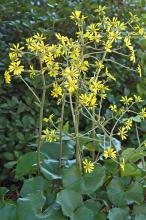Information Possibly Outdated
The information presented on this page was originally released on February 5, 2008. It may not be outdated, but please search our site for more current information. If you plan to quote or reference this information in a publication, please check with the Extension specialist or author before proceeding.
Leopard plant is made for the shade
By Norman Winter
MSU Horticulturist
Central Mississippi Research & Extension Center
If you are looking to add some character to your shade garden, then you must add the leopard plant to your mix. This terrific plant is still mostly unknown to gardeners, but new varieties are popping up that are simply irresistible.
I came across my first one a few years ago. While giving a seminar in Pascagoula, an avid gardener brought me a sample in a plastic bag so I could identify it for her. My first reaction, though I did not tell her this, was that it looked like a dichondra on steroids, which would make this an unpleasant plant.
Once I got it home, I discovered it was a Ligularia, or so I thought. As with many plants, this one had gone through a taxonomic shift and was now known as Farfugium japonicum, with the common name leopard plant. After leaving it in the plastic bag for a few weeks, I decided I would just plant it in my shady area.
Almost four years later, it has grown and thrived beyond my wildest expectations, making me wonder why it is not a staple at every garden center. I live in zone 8, and this plant has seen 17 degrees in two different winters, yet anytime I see it, it is evergreen and looking picture-perfect. Most sources say it is cold-hardy to zone 7, a few say 6B, and everyone agrees it would make a great container plant in colder areas.
As you might expect from the name japonicum, it is native to Japan. It is found growing along rocky, coastal cliffs in Japan, Korea and Taiwan. Horticultural hero Robert Fortune is credited with introducing it to England in 1856. It loves moist, fertile soil and doesn't want to dry out much. Every great leopard plant I have seen is growing in shady to filtered-light locations.
Any shady areas you have that tend to stay moist would probably be just about perfect for this plant. It typically forms clumps that will reach 2 feet wide, and some call the leaves kidney-shaped, but I describe them as more rounded, glossy and leather-like.
Some leopard plants have bright yellow spots; others have fuzzy, wavy leaves; the Gigantea has leaves that reach 1 foot wide; some might resemble kale or parsley; and still others are irregular with creamy white margins.
By now you should be thinking about how you want to give it a try, and I haven't even told you about the flowers. In October and November, 18-inch-tall spikes will form with clusters of yellow, daisy-like blossoms, adding further pizzazz to your shady area.
The leopard plant would add great contrast to an area where you might grow hostas and ferns. Use it along woodland trails, meandering streams or dry creeks that stay moist, and plant it at the edge of water gardens. It would also make a nice partner with impatiens.
The leopard plant and the newer selections are available, and they are certainly worth searching for, even if you have to urge your favorite garden center to get them for you.








